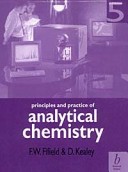There have been significant advances in both analytical instrumentation and computerised data handling during the five years since the third edition was published in 1990. Windows-based computer software is now widely available for instrument control and real-time data processing and the use of laboratory information and management systems (LIMS) has become commonplace. Whilst most analytical techniques have undergone steady improvements in instrument design, high-performance capillary electrophoresis (HPCE or CE) and two- dimensional nuclear magnetic resonance spectrometry (2D-NMR) have developed into major forces in separation science and structural analysis respectively. The powerful and versatile separation technique of CE promises to...Read more
There have been significant advances in both analytical instrumentation and computerised data handling during the five years since the third edition was published in 1990. Windows-based computer software is now widely available for instrument control and real-time data processing and the use of laboratory information and management systems (LIMS) has become commonplace. Whilst most analytical techniques have undergone steady improvements in instrument design, high-performance capillary electrophoresis (HPCE or CE) and two- dimensional nuclear magnetic resonance spectrometry (2D-NMR) have developed into major forces in separation science and structural analysis respectively. The powerful and versatile separation technique of CE promises to rival high-performance liquid chromatography, particularly in the separ- ation of low levels of substances of biological interest. The spectral inform- ation provided by various modes of 2D-NMR is enabling far more complex molecules to be studied than hitherto.
The electrophoresis section of chapter 3 and the NMR section of chapter 9 have therefore been considerably expanded in the fourth edition along with a revision of aspects of atomic spectrometry (chapter 8). New material has been included on fluorescence spectrometry (chapter 9), the use of Kovats Retention Indices in gas chroma- tography (chapter 3) and solid phase extraction for sample cleanup and concentration (chapter 12). Additions to high performance liquid chroma- tography (chapter 3) reflect the growing importance of chiral stationary phases, solvent optimization and pH control, continuous regeneration car- tridges for ion chromatography and HPLC-MS.
The electrophoresis section of chapter 3 and the NMR section of chapter 9 have therefore been considerably expanded in the fourth edition along with a revision of aspects of atomic spectrometry (chapter 8). New material has been included on fluorescence spectrometry (chapter 9), the use of Kovats Retention Indices in gas chroma- tography (chapter 3) and solid phase extraction for sample cleanup and concentration (chapter 12). Additions to high performance liquid chroma- tography (chapter 3) reflect the growing importance of chiral stationary phases, solvent optimization and pH control, continuous regeneration car- tridges for ion chromatography and HPLC-MS.
- ISBN10 0632061812
- ISBN13 9780632061815
- Publish Date December 2000 (first published December 1975)
- Publish Status Active
- Publish Country GB
- Publisher John Wiley and Sons Ltd
- Imprint Blackwell Science Ltd
- Edition 5th Revised edition
- Format eBook
- Pages 575
- Language English
